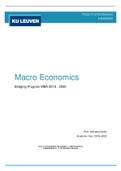Samenvatting
Macroeconomics: Summary + Notes + True/ False Statements + Exercises (Bridging MBA - KUL Brussels)
- Vak
- Instelling
- Boek
ENGLISH SUMMARY FOR BRIDGING PROGRAM MBA at KUL Prof.: Verhaest Dieter Textbook: Macroeconomics (8567); Mankiw Taylor, fifth edition This document contains a summary of the course content + own class notes + statement with solutions (at the end of the chapter) + class exercises + additional ex...
[Meer zien]






